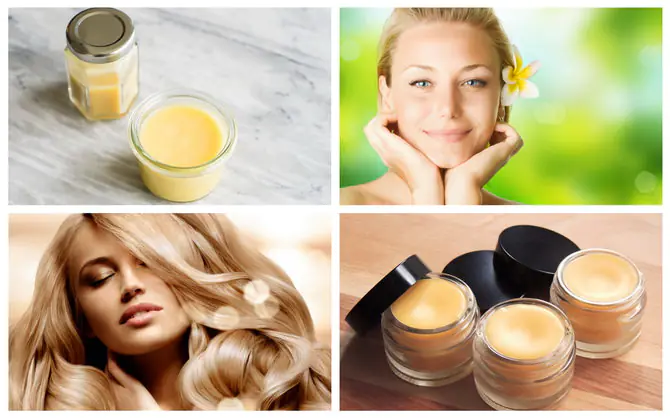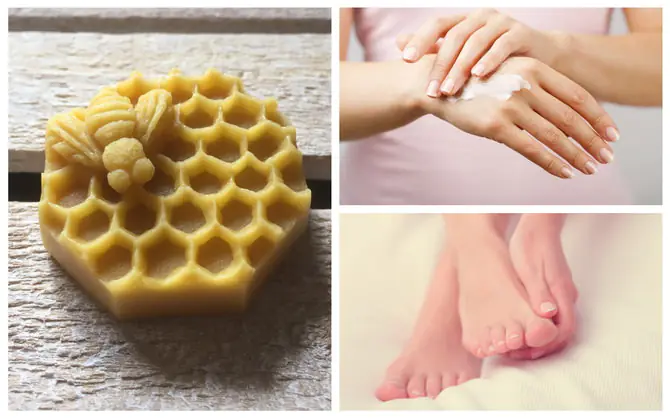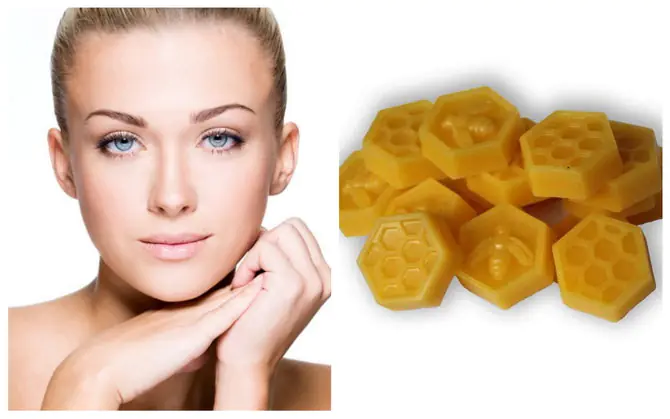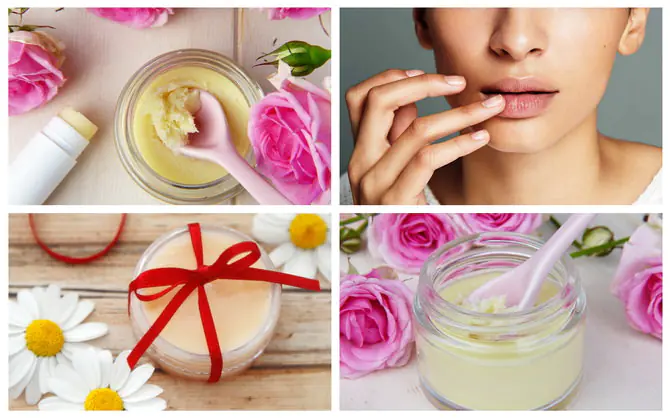Beeswax is one of the most ancient cosmetics; it has a unique composition and extraordinary biological activity. Interestingly, to this day scientists have not been able to create its complete synthetic analogue.
- Beneficial properties of wax for skin
- Use of beeswax in cosmetics
- What is beeswax in cosmetology
- Review of products containing beeswax
Beneficial properties of wax for skin
Hard-working bees build honeycombs from wax, and then seal the finished honey with it, like sealing wax. Due to its organic origin, wax has a very complex composition, which, like the composition of honey, varies depending on the habitat of bees, weather, and the quantity and quality of insect food.
Since bees need wax exclusively for housework, people used it in the same way - for beautiful melting candles, seals, and for sealing supplies. © Getty Images
What can wax do for the skin?
Bactericidal action. For both bees and people, wax serves as a kind of preservative because it prevents the growth of bacteria. In folk medicine, for example, for gum inflammation, it is recommended to chew wax.
Plasticity of the structure. The wax becomes soft already at 35 ° C, and at a higher temperature it easily melts without losing its biological properties, and just as easily hardens, taking on any shape and forming a film of any thickness. This property is used not only in cosmetics - wax is often used to create fantastic “faces” of characters in movies.
Elasticity of form. Warm wax can be crushed like plasticine, creating objects of any shape and size from it, including microgranules for gommages.
Wound healing effect. On the one hand, wax acts as a natural glue, and on the other, it has bactericidal properties and a rich composition that stimulates tissue regeneration.
Waterproof. Otherwise, its preservative properties would be worthless. Wax does not dissolve in water, so the thin protective film formed by it protects the skin from moisture loss.
Breathability. Honey, which is sealed in wax combs, is protected from foreign components from the outside, but can still “breathe”. And so does the skin under cosmetics with wax.
Saturation biologically active substances and a rich vitamin-mineral and antioxidant composition.
Compound
Wax is a very complex substance; it consists of several hundred different elements. The concentration of most of them is negligible, but it is precisely this “bouquet” that made this natural product miraculous. The composition of the wax includes important for the skin:
fatty acids, including omega-9;
carotenoids (provitamin A);
sterols and sterols;
propolis (traces of it are always contained in beeswax).
Use of beeswax in cosmetics
For hair
Wax has long been one of the most popular styling products. It is usually released in stick format. It is enough to take a little product with your fingers and lightly run them through your hair to ensure reliability of the styling (and at the same time a slight lamination effect). The main thing is not to overdo it, the wax does not dissolve in water, so it will not be possible to wash it off without the help of special tools.
For lips
Wax often serves as a base for lipsticks. It holds its shape perfectly and becomes soft at body temperature. In addition to texture, its ability to “seal” small wounds and cracks and retain moisture is important.
When you see cosmetics in a stick (lipstick, concealer, deodorant), know: most likely it is based on wax. © Getty Images
For exfoliation
“For those who are afraid of acids, as well as for those with sensitive skin who love scrubs for a soft massage and a fresh glow, exfoliant creams and gommages are intended. Their exfoliating particles are granules of wax and jojoba oil (which, by the way, is also not really an oil, but a waxy plant substance), they do not allow you to scratch the skin.”
For acne
A corrector for masking local imperfections in the form of a stick is indispensable in the purse of a girl with problem skin. Like lipstick, it usually has a wax base. Conveniently, in addition to its dense texture, wax also has bactericidal properties, that is, it prevents the development of infection, and also contains provitamin A - this antioxidant stimulates skin regeneration.
For wrinkles
Wax helps smooth the skin and form a thin film on its surface, which “patches” the hydrolipid mantle.
For feet and hands
Thick wax with its regenerating and protective moisturizing effect is widely used in restorative creams for hands and feet, where the skin is especially susceptible to cracks and dryness. Wax allows you to create a semblance of a second skin, that is, it protects the epidermis from damage and at the same time helps it recover due to the content of provitamin A, as well as other components.
For depilation
Perhaps wax is the first epilator in human history. To this day, strips with wax applied to them are used in different countries. The sticky substance, slightly heated, sticks tightly to the skin. By sharply tearing off the strip, you will remove the hairs frozen in it. You can use ready-made strips, hot wax, cold wax - the effect and mechanism of action are the same.
What is beeswax in cosmetology
In cosmetology, wax is one of the timeless classics.
Epilation
The procedure described above can be entrusted to a cosmetologist. And with a high degree of probability you will get a better result, if only because it is difficult to get to some areas on your own. In addition, professional hair removal products are usually supplemented with caring components.
Massage with wax
This is a relatively new type of massage. Since wax has a warming effect, the skin underneath it is steamed and the blood supply to the tissues is increased. The hands do not slide over the body, but rather knead it, acting on the subcutaneous fat.
Paraffin therapy
For this warming procedure, they use not beeswax, but paraffin, but it has the same properties: hands or feet are lowered into the heated liquid substance for just a few seconds, then taken out. In air, paraffin, like wax, instantly hardens, forming “gloves” or “socks”. The skin inside warms up, blood circulation improves, and the hydrolipid barrier is restored.
When the paraffin “gloves” are removed (like rubber gloves), the skin remains soft and tender. © Getty Images
Review of products containing beeswax
Corrective SOS stick for masking dark circles and skin imperfections Dermablend, Vichy reliably hides any imperfections and stays on the skin all day. The stick is based on beeswax in combination with other types of wax.
Care for dry skin of babies, children and adults Lipikar Stick AP+, La Roche-Posay instantly soothes skin prone to atopy and itching thanks to a composition enriched with madecassoside, shea butter and zinc. And the dense, comfortable structure of the stick is created by beeswax and paraffin.
Moisturizing lip balm Depsea Hydrability, Shu Uemura contains beeswax and macadamia oil, nourishes, protects against dryness.
Night cream for intensive recovery Absolue Precious Cells, Lancôme contains beeswax. The cream stimulates cellular renewal.
Cream-serum Forever Youth Liberator Sérum-En-Crème, Yves Saint-Laurent — the anti-aging effect of the unique Glycanactif complex is supported by the smoothing effect of wax.
Anyone who even superficially imagines the life of bees knows that beeswax is an ideal building material for the construction of honeycombs. But this does not limit the range of its application, which affects a variety of areas.
For example, beeswax is an excellent way to protect cheese from mold and to protect fruits from water loss. It is used to make dietary supplements and is added to soft gelatin capsules for tablets. And this is only a small part of the areas where wax can be used.
But what does beeswax have to do with cosmetology and why is it so important in the production of cosmetics? The thing is that beeswax, like other products produced in the apiary, has a number of therapeutic properties that are extremely useful in cosmetology. This will be discussed further.
Why is beeswax used in cosmetology?
The protective and nutritional properties of beeswax, its ability to thicken and stabilize emulsions - all this has found application in cosmetology.
The range of applications of beeswax in the production of cosmetics includes balms and lip glosses, whitening, nourishing, astringent, sunscreens for hands, face and body, moisturizing and cleansing masks, eye shadows and mascara, lipstick and blush, shaving products, hair care, nail care, coloring products and even deodorants.
So why is beeswax so popular in cosmetology?
First of all, due to its chemical and natural properties. The wax is waterproof, not subject to oxidation, has chemical resistance, has a high melting point and a fairly hard structure. It is a natural emulsifier (easily mixed with any oils).

All these features make beeswax one of the indispensable components in the production of cosmetics, which acts as a thickener, structure-forming component, preservative and stable base.
Wax affects the heat resistance and density of cosmetic products, gives them hardness, matte, plasticity, and is also used in creams intended for feet, hands, lips, skin protectants and other cosmetic products as an emollient ingredient.
Preparations that are created on the basis of wax have an excellent structure and are perfectly stored.
Natural beeswax is superior in spectrum of action and composition to any synthetic component used in the production of similar cosmetics. As part of creams, ointments and masks, wax helps get rid of wrinkles, makes the skin soft and well-groomed, prolonging its youth.
The unusually rich chemical composition of wax enhances the positive effects of cosmetic preparations on the skin.
What are the benefits of beeswax for skin?
Even a very superficial acquaintance with the healing properties of this product, created by nature itself, gives an idea of the incredible benefits of beeswax for the face and skin condition in general. Let's look at some of its beneficial properties.
It is difficult to find a more effective natural moisturizer in nature than wax. Its ability to attract and retain the optimal amount of water in skin cells is the best guarantee that the skin will always be elastic, beautiful and smooth.
Wax, having the unique property of protecting the skin from harmful external influences, turning into an imperceptible and invisible film in the cream, does not at all interfere with the skin’s ability to breathe. Thanks to this product, skin dryness is significantly reduced, it is protected from dehydration and premature aging.

- Softening, nourishing and healing
Possessing anti-inflammatory properties, beeswax perfectly heals wounds, cracks, burns and other damage. Any preparation with beeswax can be used as an antipruritic and wound healing agent. This is partly due to the presence of vitamin A in its composition, which regulates the normal development of the skin epithelium and cells. It treats skin diseases and protects it from the harmful effects of aggressive substances.
- Antibacterial and anti-inflammatory effect
Regular use of beeswax in creams and masks, due to its anti-inflammatory properties, leads to good results in the treatment of many skin diseases (redness, acne, pimples). The effectiveness of such procedures is ensured due to the peculiarity of beeswax not to clog skin pores.
Using wax in home cosmetology
Natural cosmetics cost a lot of money if you buy them in salons and cosmetic stores. But you can also prepare a lot of different and healthy nourishing creams, masks and scrubs at home based on such a natural bee product as wax.
Most of the ingredients for homemade cosmetics can probably be found in your medicine cabinet or kitchen. And the missing components can be purchased at your nearest pharmacy. The only thing that can be difficult is finding quality wax. It is better to buy it (like other beekeeping products) from a beekeeper who guarantees the suitability and effectiveness of the wax.
The advantage of making homemade cosmetics is that you can take numerous recipes as a basis, and then, using your imagination, you can create many of your own options. This process is extremely exciting and creative.
You can change the components recommended in a particular recipe for your favorite ones, select them for yourself, come up with new ideas, and experiment. A small quantitative deviation of one or another component in one direction or another will not lead to any fatal side effects. Well, except that it may affect the physical characteristics of the prepared product (it may turn out to be too thick or, on the contrary, too liquid).
Rules for preparing wax-based cosmetics
- When making homemade creams and masks, it is often recommended to use purified wax. Although not everyone supports this point of view.
- The permissible concentration of beeswax in cosmetics is 0.5-10% of the total mass. It depends on the purpose of the cosmetic product. For example, it is not recommended to use more than 1% beeswax in face protection products. In creams and masks intended for oily and problem skin, the amount of wax should not exceed 0.5%.
- You can use not only fresh wax, just obtained in the apiary, but also stored for a long time in a separate sealed container.
- The wax can only be heated in a water bath, stirring constantly, in a container made of heat-resistant glass, aluminum or in an enamel container. Copper, cast iron, or iron utensils should not be used to melt wax to prevent a reaction between certain types of metal with the fatty acids contained in the wax.
- When preparing the base for cosmetics on fire, you cannot go away and leave this process uncontrolled. Wax is a flammable product.
- Beeswax used in making homemade cosmetics should not be melted in one piece. It should first be planed with a knife or grated.
By following these simple rules, you can prepare at home many creams, healing masks, balms, the main component of which is beeswax.

Recipes for natural cosmetics with beeswax
Our skin doesn't always make us happy. For some, it is too dry, for others, it is oily, for others, the first wrinkles and signs of aging appeared very early, while others are plagued by acne. And this is where beeswax for the face can help many. Perhaps you will take some of these recipes into your beauty bag for folk self-care products.
Anti-wrinkle cream
Mix 30 g of wax and honey. Add 10 ml of aloe juice and 20 ml of white lily tincture. Heat the mixture over low heat for about 30 minutes. Then filter it and apply it to previously cleansed facial skin.
Mask against peeling skin
Mix cucumber, carrot, zucchini juices, olive oil and liquid wax in equal proportions. Apply to face for 20 minutes.
Moisturizing body cream
Compound:
- beeswax – 2 tbsp. l.
- cocoa butter, coconut oil - 2 tbsp. l.
- sweet almonds – 4 tbsp. l.
- distilled water – 2 tsp.
Melt the wax with water over low heat and mix with oils.
Lip balm
If you have chapped and dry lips, a homemade beeswax balm will help you cope with this problem.

To prepare it, take 1 teaspoon of melted wax and the same amount of any moisturizing oil (almond, olive, coconut), 2 teaspoons of cocoa butter, a small amount of vitamin E (one capsule) and two or three drops of your favorite essential oil (orange or lemon, peppermint oil). If desired, you can add a little honey.
That's all we need to restore our lips' softness, elasticity and delicate appearance. You can use the balm like regular lipstick. It forms a protective film, nourishes and moisturizes the skin of the lips.
Antiseptic lip balm
We will need:
- beeswax – 60 ml
- jojoba oil – 30 ml
- almond oil – 90 ml
- tea tree essential oil – 20 drops
Oils must be heated with wax. The ratio of oils and beeswax in cosmetic products is approximately calculated as follows: 1 part wax should be 2 parts oil.
To make sure that the mixture has the desired density and consistency, you need to wait until it cools and thickens. If the cream turns out to be a thinner consistency, you can add a little wax. If too thick, add a little oil and heat again.
To improve the therapeutic effect, essential oils are added to the cooled mixture.
Hand cream
To get 100 ml of cream, you will need 50 ml of water (can be replaced with a decoction of herbs), any vegetable oil (50 ml), wax (5 g), essential oil (lavender, lemon or any other at the rate of 30 drops per 100 ml) and others components upon request and subject to availability.
This cream can be used to care not only for your hands, but also for your feet, body and face.
In all cases of using beeswax in cosmetology, remember that essential oils and bee products can cause allergies, so be careful.
Softens, heals, brightens the skin and tightens pores.
Concentration of beeswax in cosmetics (Cera Alba, Beeswax) is 3-6% in creams and masks, about 5% in decorative cosmetics, up to 10% in lipsticks and lip balms.
Properties of beeswax used in cosmetics:
Cleansing. Beeswax in cosmetics helps tighten pores and gets rid of blackheads.
Anti-aging. Smoothes wrinkles, deeply nourishes the skin with vitamins and fatty acids, helps retain moisture in the skin, makes it smooth and matte.
Emollient. It is slowly absorbed by the skin and deeply nourishes it without clogging pores.
Anti-inflammatory. Beeswax is rich in bactericidal substances and fights the appearance of acne and any pustular rash.
Healing. Beeswax in cosmetics heals cracks in chapped skin and sunburn.
Strengthening. Beeswax in cosmetics prevents split ends, gives hair smoothness and manageability, and nourishes hair follicles.
Whitening. Beeswax reduces pigmentation and lightens freckles.
In what cosmetics is beeswax found?
- anti-age nourishing face creams with beeswax
- lotion for problem skin
- cleansing masks, skin lotions
- whitening face cream
- nourishing night cream for face and body
- softening hand cream
- nail care products
- depilatory products
- sun protection cosmetics
- softening cosmetics for feet
- hair strengthening masks
- children's cosmetics
- lipstick, lip balm
- eyeshadow
- blush
- solid perfume
- soap
Cosmetics with beeswax are stored away from direct sunlight, in a cool place.
The use of cosmetics with beeswax is undesirable:
- if you are allergic to honey and other bee products
- for hypersensitive skin
What is beeswax in cosmetology?
Beeswax is a product secreted by special glands of young worker bees. It has a fine-grained, fragile structure and is deposited on the surface of the bee's abdomen in the form of transparent plates. Bees use wax to build honeycombs and seal honey within them.
Where do you get beeswax for cosmetics?
To obtain beeswax, honey is pumped out of honeycombs, and the honeycombs themselves are squeezed out in presses and melted in hot water to remove residual honey and mechanical impurities. When the water cools, the beeswax floats to the surface. It is collected, melted again, filtered and poured into molds. This beeswax usually has a yellow color with a brown tint and a faint honey smell. It is called Cera flava and is used for medicinal or culinary purposes. For use in the pharmaceutical or cosmetics industry, beeswax is bleached. To do this, after purification, it is poured into a thin layer and exposed to sunlight or UV rays. In this case, the yellow pigments are destroyed, such wax is odorless and is called Cera alba. For technical purposes, beeswax is bleached with oxidizing agents.
Beeswax is biologically active, non-toxic, insoluble in water and acids, but highly soluble in fats.
Today, scientists have not been able to fully decipher the composition of beeswax and reproduce it artificially. However, it is known that beeswax contains esters of saturated fatty acids, vitamin A, carotenoids, carbohydrates, mineral compounds, substances with antibiotic properties and preservative components. Beeswax is used as a food additive and a variety of protective mastics. The plasticizing and nutritional properties of beeswax, as well as its ability to stabilize and thicken emulsions, are widely used in the pharmaceutical and cosmetic industries.
What else is beeswax used for?
For medical purposes, beeswax is used in suppositories and emulsions as a stabilizing and bactericidal component. In folk medicine, beeswax is widely used in the form of applications to enhance lactation, relieve symptoms of sinusitis, treat trophic ulcers, and soften corns. Beeswax is chewed to relieve inflammation of the gums, added to hot drinks to treat bronchitis, and treat furunculosis and lupus.
We have been using wax since time immemorial: we rubbed wax on wooden tablets and wrote on them, wax was used to make ritual candles and embalm bodies, bright and long-lasting paints were made from wax, and the healing properties of beeswax were mentioned in the ancient Egyptian Ebers papyrus. Its anti-inflammatory and healing abilities were especially valued. Later, Hippocrates recommended the use of beeswax for sore throats, and Avicenna prescribed it for debilitating coughs.



